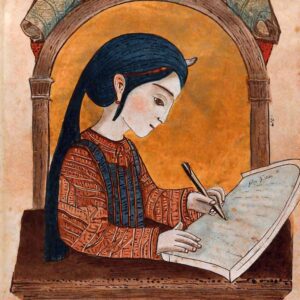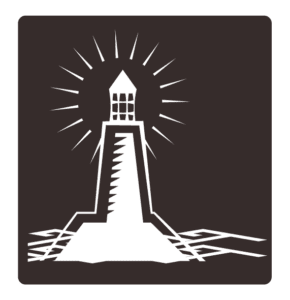
II- Preparation of the Game
Preparation of the Rounds Chart, the Game Direction Sheet and the Campaign Sheets
What is the Rounds Chart and the Game Direction Sheet
 It can be said that the Rounds Chart and the Game Direction Sheet are, respectively, the time and space planning of the game.
It can be said that the Rounds Chart and the Game Direction Sheet are, respectively, the time and space planning of the game.
The Rounds Chart is a space where the GM must indicate, for his own reference, the events that will occur automatically when the game reaches a certain Round (that is, when a certain GM turn is reached). The Game Direction Sheet is used for the GM to note the Eido in which the Coin or Coins hidden in that archipelago are located and other unique elements other than those that characterize the Places.
The Rounds Chart and the Game Direction Sheet are created by the GM before the start of the game. To do this, he can take a sheet of paper and fold it in half, using one side for the Rounds Chart and the other for the Game Direction Sheet.
Making of the Rounds Chart
The GM can choose which events to include in the Rounds Chart, with the exception of the initial state of the tides and weather, which are mandatory, although they can remain stable throughout the game. Below is a brief explanation of the gameplay implications of these items.
The tides
Under high tide conditions, intertidal Eidos (those found between the two yellow lines outlining the coast) are submerged, and therefore only sea Eidos that have their boundaries above them will be taken into account. At low tide, the Eidos in this area are exposed and the Type of Terrain they display must be considered (Intertidal rocks - including those covered in algae - or wet sand). The intertidal Eidos that are attached to the coast at low tide (and the parts of them that form islets when the tide rises) are marked with a number and a letter (1b, 1c, 1d...). Each one of them is a different Eido, although they coincide in the initial number.
The weather
Cada un dos estados do tempo leva aparellado un distinto nivel de risco nos desprazamentos polo aire e polos cantís. Ademais, correspóndese cun estado do mar, o cal inflúe nas posibilidades de desprazamento e riscos asociados ás travesías. Así, o Bo Tempo (TB) se correlaciona con Augas Tranquilas, o Tempo Revolto (TR) con Augas Picadas e o Temporal (TM) coa situación do mar homónima.
Events that can be included in the Rounds Chart
The events that can be “scheduled” in the Rounds Chart are the following:
- Weather changes. The weather situation can vary between Good Weather (TB), Messy Weather (TR) and Storm (TM). Good Weather and Storm will have a minimum duration of 10 Rounds, and Messy Weather, 5. It will not be possible to go directly from Good Weather to Storm, and vice versa, without a transition of a minimum of 5 rounds of Messy Weather. The GM can decide to keep the weather unchanged throughout the game. In any case, he must indicate the weather situation for Round 1.
- Tide level changes. The tide takes 60 rounds to change between its extreme values, so this will only happen in very long campaigns (games with many sessions) or when temporary ellipses are made in the middle of the game. In any case, the GM must note the tide level for Round 1. Intermediate levels between maximum and minimum of sea levels will not be taken into account, although it is at the GM's free disposal to allow certain movements by land or by sea. water in intertidal zones when the tide approaches its maximum or minimum.
- Irruption of any NPC or animal (including Monsters) into a specific Eido on the board, which will now be available to the GM as an Activated NPC or Animal.
- Aparición dun SDI nun Eido distinto daquel no que normalmente se atopa.
- Other events (to the GM's free imagination)
Changes from day to night (Advanced rulesets)
In advanced rules it will be possible to change the time of day (at night the abilities of many PCs, NPCs and animals will be different); and even the time of year.
No inverno a noite durará entre 150 e 90 roldas e o día entre 90 e 120. No verán, invértense estas duracións de día e noite. En primavera a noite dura de 120 a 90 roldas e o día de 120 a 150, con valores inversos para o outono.
Preparation of the Game Direction Sheet
On the Game Direction Sheet, the GM will write down the Eidos (referring to them by the number or number and letter with which they are marked on the board) where he wants to place the following elements:
- The Coin or Coins that the PC's must find.
- Valuable objects (jewelry, talismans, weapons...).
- Species of animals and plants (based on information found on the distribution of species, on the game website or from other sources, as explained above).
- The NPC's existing in that archipelago
- The Lord or Lady of the Islands of the archipelago (When it does not have a fixed location).
- Optionally, the GM can note on this sheet the Tests that the PCs must pass to obtain the positive items mentioned or avoid the negative ones, mark Eidos with Traps and add other elements that he wants to include in the games.
Specifications on sea Eidos and Eidos that are Places
In the case of sea Eidos with several levels of depth, the GM must indicate in which area of the Eido the Coin, valuable object, Plant, Animal or NPC that he wants to place in that Eido is located.
In the Eidos that are a Place (Lg) the GM must specify the Treasures, Threats or Coin that might be in the singular space or in relation to the special element that is in that Eido in a differentiated manner with respect to those in the rest of the Eido. For example, in an Eido that includes a sea cave, a building, a pond or a Lavoir, he/she will note the elements that may be inside it; If there is a petroglyph, he/she will note what happens when the PC activates it with a spell, etc.
In any case, he/she will be guided by the restrictions included in the Games Guide
Preparation of PC and GM Campaign Sheets
During the game, the PCs will need to keep track of aspects such as the movement points they have left to “pay” to go through an Eido, the Wounds (x) they suffer, the turns they must remain without moving due to different circumstances, the Treasures (Ts) that they carry with them, the Gifts that were granted to them... as well as the modifications to their movement capacity, VL, VE, in the, nR, VcAn and VcM. To keep track of all this, the easiest thing is to write everything down on a piece of paper (half a sheet of paper may be enough). If preferred, on this website there will be downloadable models with circles to cross out and keep track of wounds, boxes where you can write down the remaining Movement Points, areas to write down equipment, etc. These models can be printed on an A5 size sheet of paper, which also allows you to print the Character Sheet (which will also be available online) on the back.
Beyond practical notes like those described, the PC can also write their PC's name on this sheet, and all the details they want to personalize it.
The GM will also have his own Campaign Sheet, where he will make notes regarding the NPCs and Activated Animals (Movement Points they need to overcome an Eido, Wounds, etc.) as well as the check rolls he must perform on his turn.

